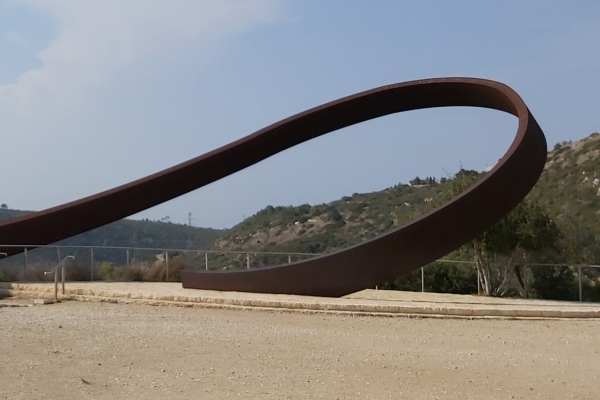Carmel Memorial - Ten Years Since Disaster
Text and photos: Lydia Aisenberg
Four large flags, standing side by side atop huge metal posts, flap noisily in a very strong late autumn breeze.
The wind is more than welcoming on a rather hot November day as this writer stands on a Carmel mountain range hill, under the shadow of Kibbutz Beit Oren sitting on a close but higher promontory, and looking down over a huge expanse of magnificent greenery, the flat-as-a- pancake Israeli coastline, and far out across the Mediterranean sea.
However, the much appreciated caressing breeze fanning one's face would be far from positive if one had to battle a ferocious forest fire raging through the vast area sprawled out on either side, above and below this point -as did hundreds of Israeli and foreign fire-fighters a decade ago for four long days and nights as they battled a raging fire of previously unknown scale in Israel.
The blaze scorched over 2,500 acres of the Carmel mountain range, destroyed anywhere up to five million trees, wiped out a large part of the wildlife in the immediate area and burned down dozens of homes and public buildings in Kibbutz Beit Oren, Yemin Orde Youth Village, the Ein Hod artists village, and other nearby communities.
The Carmel hilltop showing off the wonderous, breathtaking vista below, is also the site of a heart-wrenching and thought-provoking memorial to the 41 Israeli firefighters and police officers who lost their lives in the Carmel disaster in the first week of December 2010.
The extremely eye-catching from a distance hilltop monument has been created close to a twisting, turning part of the super scenic road separating the kibbutz from the lower hills. It was near here on that portion of the road that the ferocious fire trapped a bus carrying Israel Prison Service cadets who had been sent to help with the evacuation of prisoners from the Damon prison situated on the Carmel, close to the mountain top Druze town of Usifiya where it would seem the blaze began, ignited by sparks emanating from an illegal rubbish dump run by locals.
All but three of the over thirty young cadets aboard, and the bus driver, perished after having left the bus to run down a slope at the side of the road, only to be trapped on all sides by the fire.
The three survivors miraculously found a smoke filled hiking path and escaped the inferno, as did two Israeli photographers, one of whom continuing to take photographs through a car window as the other frantically drove to and fro, eventually finding an opening to flee the area.
Tragically, two police vehicles and a fire truck that had initially been with the photographers cars did not find a way out and three high ranking Haifa based Israeli police officers, two men and one woman, perished as did two firemen in the truck and a 16 year-old Israeli Fire and Rescue cadet who had convinced his mother to drive him to the area so that he could join his peers fighting the fire. Unable to find his peers, the teen had joined the two-man fireman team and also perished.
One of the many photographs later published, showed the youngster sitting between the two firefighters as smoke swirled around the truck.
Last December, 10 Israeli children celebrated their 10th birthdays without having ever known their fathers, all of whom – including a twin brother and sister – lost their fathers in the fire.
The names of all the victims are inscribed on a portion of curved wall at the side of which is a hazy, black and white photograph of the grotesquely twisted metal skeleton of the Israel Rescue and Fire Services bus, the image of which is ingrained in the memories of many Israelis from the tragedy a decade ago, almost to the day.
A long curved piece of rust-coloured cast iron, weighing a massive 44 tons, sits atop the wide solid concrete memorial wall but then seemingly shoots off, rises toward the sky, curves back on itself in loop fashion, truly representing the far reach and deadliness of a flame.
Where the metal turns back on itself to the ground, if one stands with one's back to the concrete wall, Kibbutz Beit Oren perched atop the neighbouring hilltop, seems to be framed, new houses replacing those destroyed sitting within the massive iron loop, small bushes and trees giving some greenery to what were once lusciously green-covered slopes.
The creative, sophisticated and poignant twist of the far-reaching iron flame seemingly encircling the kibbutz on high, but that snatched the lives of so many, is also a stark reminder of just how vulnerable are the forests and their surroundings when fire rages through.










Comments